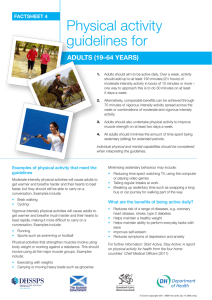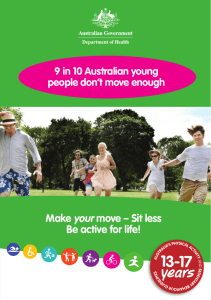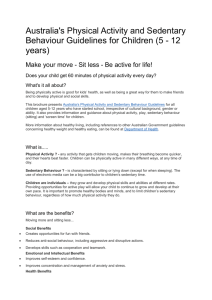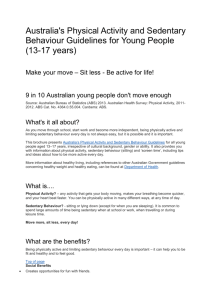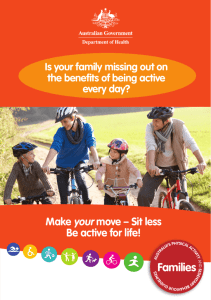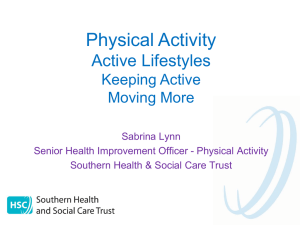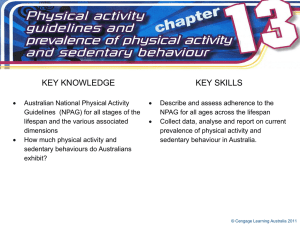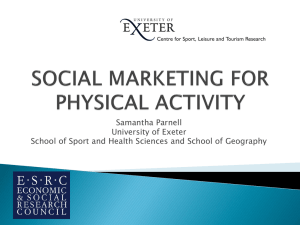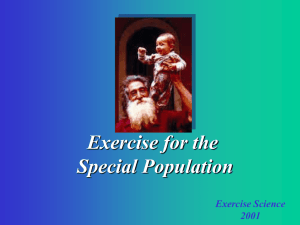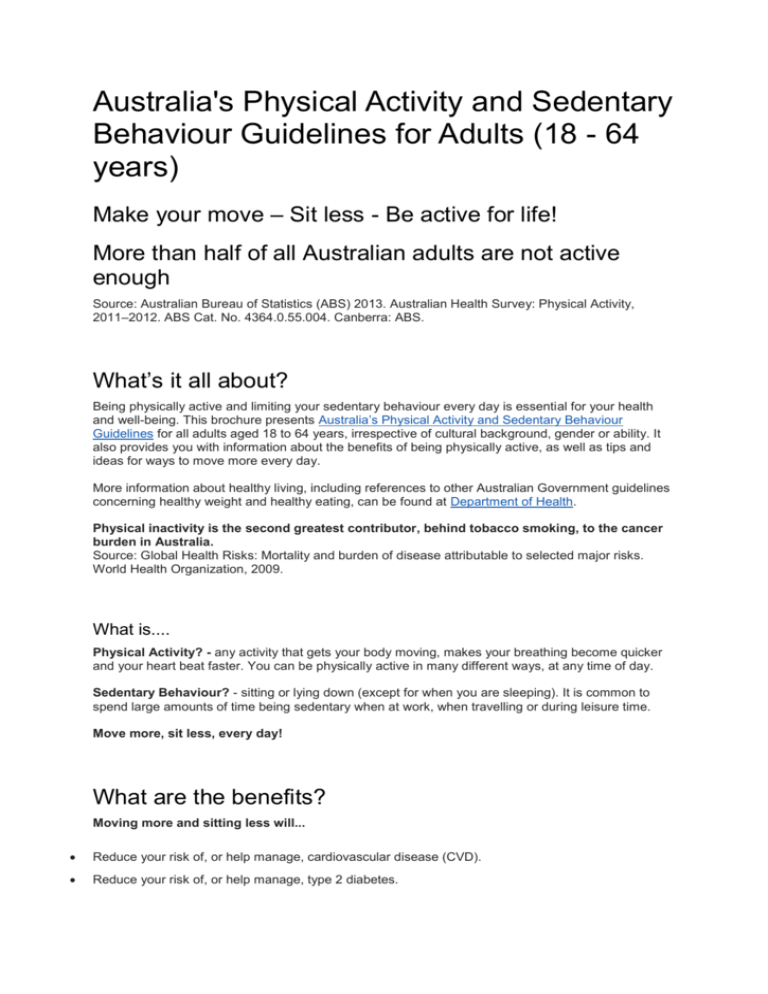
Australia's Physical Activity and Sedentary
Behaviour Guidelines for Adults (18 - 64
years)
Make your move – Sit less - Be active for life!
More than half of all Australian adults are not active
enough
Source: Australian Bureau of Statistics (ABS) 2013. Australian Health Survey: Physical Activity,
2011–2012. ABS Cat. No. 4364.0.55.004. Canberra: ABS.
What’s it all about?
Being physically active and limiting your sedentary behaviour every day is essential for your health
and well-being. This brochure presents Australia’s Physical Activity and Sedentary Behaviour
Guidelines for all adults aged 18 to 64 years, irrespective of cultural background, gender or ability. It
also provides you with information about the benefits of being physically active, as well as tips and
ideas for ways to move more every day.
More information about healthy living, including references to other Australian Government guidelines
concerning healthy weight and healthy eating, can be found at Department of Health.
Physical inactivity is the second greatest contributor, behind tobacco smoking, to the cancer
burden in Australia.
Source: Global Health Risks: Mortality and burden of disease attributable to selected major risks.
World Health Organization, 2009.
What is....
Physical Activity? - any activity that gets your body moving, makes your breathing become quicker
and your heart beat faster. You can be physically active in many different ways, at any time of day.
Sedentary Behaviour? - sitting or lying down (except for when you are sleeping). It is common to
spend large amounts of time being sedentary when at work, when travelling or during leisure time.
Move more, sit less, every day!
What are the benefits?
Moving more and sitting less will...
Reduce your risk of, or help manage, cardiovascular disease (CVD).
Reduce your risk of, or help manage, type 2 diabetes.
Maintain and/or improve your blood pressure, cholesterol and blood sugar levels.
Reduce your risk of, and assist with rehabilitation from, some cancers.
Help prevent unhealthy weight gain and assist with weight loss.
Build strong muscles and bones.Top of page
Create opportunities for socialising and meeting new people.
Help you to prevent and manage mental health problems.
Help you develop and maintain overall physical and mental well-being.
...and the more active I am, the more I will benefit.
Did you know that higher levels of physical activity can help reduce your risk of some cancers
and prevent unhealthy weight gain?
Move more...
Doing any physical activity is better than doing none.
If you are not currently doing any physical activity, you will benefit from starting some. You can start
slowly and gradually increase the amount you do. Consult your doctor for advice on the best types of
physical activity for you.
You can accumulate your activity by being active on most, preferably all, days every week.
Each week:
150 minutes (2 ½ hours) of moderate intensity physical activity, or
75 minutes (1 ¼ hours) of vigorous intensity physical activity, will help improve blood pressure,
cholesterol, heart health, as well as muscle and bone strength.
Each week, increasing to:
300 minutes (5 hours) of moderate intensity physical activity, or
150 minutes (2 ½ hours) of vigorous intensity physical activity, will provide greater benefits and help
prevent some cancers and unhealthy weight gain.
Moderate Intensity Activities take some effort, but you are still able to talk while doing them.
E.g. a brisk walk, recreational swimming, dancing, social tennis, golf, household tasks like cleaning
windows or raking leaves, or pushing a stroller.
Vigorous Intensity Activities require more effort and make you breathe harder and faster (‘huff and
puff’).
E.g. jogging, aerobics, fast cycling, many organised sports and tasks that involve lifting, carrying or
digging.
I could do at least 30 minutes of physical activity on 5 days of the week.
I could enjoy a bike ride or game of tennis with friends.
I could invite some friends to the dance class I’ve signed up for.
I could go for a 15 minute jog before breakfast every day.
A time saving tip - You may choose to do a combination of moderate and vigorous intensity
activities. 10 minutes of vigorous intensity activity is equal to 20 minutes of moderate intensity activity.
Top of page
...and sit less!
Even if you do more than the recommended amount of physical activity every week, you will still
benefit from minimising time spent sitting each day, and from regularly interrupting periods of sitting.
Break up long periods of sitting as often as possible. 56% of Australian adults are either
inactive or have low levels of physical activity - that is more than 9.5 million adults!1
Source: Australian Bureau of Statistics (ABS) 2013. Australian Health Survey: Physical Activity,
201112. ABC Cat. No. 4364.0.55.004. Canberra: ABS.
Sedentary behaviour is associated with poorer health outcomes, including an increased risk of type 2
diabetes.
Be aware of time spent in front of the screen.
Watching TV and DVDs, playing electronic games, using computers and surfing the internet may all
be popular activities, but they usually involve either sitting or lying down for long periods.
I could turn off the TV during the day and get out in the garden.
I could visit my colleague to deliver the message in person.
I could set an alarm on my computer to remind me to stand up more often.
There are many opportunities to sit in our daily lives. The key is to find opportunities to move.
What will you do?
Getting stronger
The Guidelines recommend including muscle strengthening activities on at least 2 days each week.
Did you know, that regular muscle strengthening activities will help to:
Manage blood pressure, blood sugar and blood cholesterol levels.
Prevent and control heart disease and type 2 diabetes.
Improve posture, mobility and balance.
Reduce the risk of falls and injury.
Maintain your ability to do everyday tasks.
I could do body weight exercises, like push-ups, squats or lunges, at home.
I could do tasks around the house that involve lifting, carrying or digging.
I could join a gym and do weights or other resistance training.
What will you do?
Why not try these ideas?
Think about when and where you can be physically active. Making some small changes to your daily
routine can make a big difference.
Top of page
Active Travel
For short trips, walk or cycle and leave the car at home.
For longer trips, walk or cycle part of the way.
Use the stairs instead of the lift or escalator.
Get off the bus one stop earlier and walk the rest of the way.
Park further away from your destination and walk – you may even save on parking fees.
Active at work
Park your car an extra 5 or 10 minute walk from work.
Walk to deliver a message rather than emailing or making a phone call.
Leave your desk at lunch time and enjoy a short walk outside.
Organise walking meetings.
Active and Fun
Catch up with friends for a walk, instead of sitting to chat.
Plan outdoor activities, like bike riding or walking.
Don’t let the weather stop you. Try indoor activities like dancing, indoor swimming, squash or indoor
rock climbing.
Active and Safe
If you are new to physical activity, have a health problem, or are concerned about the safety of being
(more) active, speak with your doctor or health professional about the most suitable activities for you.
Protect yourself from the sun – you should wear sun-protective clothing, including a hat, and apply
sunscreen regularly.
Be active every day in as many ways as you can!
Australia’s Physical Activity and Sedentary Behaviour
Guidelines for Adults (18–64 years)
Physical Activity
Doing any physical activity is better than doing none. If you currently do no physical activity, start by
doing some, and gradually build up to the recommended amount.
Be active on most, preferably all, days every week.
Accumulate 150 to 300 minutes (2 ½ to 5 hours) of moderate intensity physical activity or 75 to 150
minutes (1 ¼ to 2 ½ hours) of vigorous intensity physical activity, or an equivalent combination of both
moderate and vigorous activities, each week.
Do muscle strengthening activities on at least 2 days each week.
Sedentary Behaviour
Minimise the amount of time spent in prolonged sitting.
Break up long periods of sitting as often as possible.Top of page
Australia's Physical Activity and Sedentary Behaviour Guidelines
Move and Play Every Day – National Physical Activity Recommendations for Children 0-5 Years.
Make your move – Sit less – Be active for life!
o
Children (5-12 years)
o
Young People (13-17 years)
o
Adults (18-64 years)
o
Families
Choose Health: Be Active – A physical activity guide for older Australians.
To order these resources FREE OF CHARGE, phone 1800 020 103
Other Healthy Living Resources:
Healthy Weight Guide
Eat for Health
Clinical Practice Guidelines for the Management of Overweight and Obesity in Adults, Adolescents
and Children in Australia
Get Up & Grow – Healthy Eating and Physical Activity for Early Childhood (for centre based care,
family day care and pre-schools)
To find out more, go to Department of Health.
1 Australian Bureau of Statistics (ABS) 2013. Australian Health Survey: Physical
Activity, 2011-12, 2011-12. ABC Cat. No. 4364.0.55.004. Canberra: ABS.
© Commonwealth of Australia 2014, except for the images/photographs which are reproduced under
licence. All rights are reserved, unless permitted by the copyright Act 1968 (Cth). All information in
this publication is correct as at June 2014.

